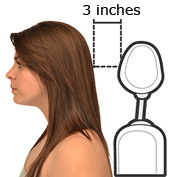 Whiplash is not a true medical term but is more of an expression used to describe an injury to the spine that occurs when unexpected movement of your neck comes to an abrupt and grinding halt. There are a lot of misconceptions surrounding whiplash. To see where you are in your understanding of the condition, take the following five question quiz. Let's get started.
Whiplash is not a true medical term but is more of an expression used to describe an injury to the spine that occurs when unexpected movement of your neck comes to an abrupt and grinding halt. There are a lot of misconceptions surrounding whiplash. To see where you are in your understanding of the condition, take the following five question quiz. Let's get started.
(Answers follow the last question)
1. The average collision speed in most rear-end automobile accidents is:
- 10-25 mph
- 15-30 mph
- 1-5 mph
- 6-12 mph
2. Regarding healing of injuries from whiplash, which of the following is most accurate:
- The majority of whiplash injuries recover in about 6 weeks
- The majority of whiplash injuries recover in about 6-12 weeks
- About 25-50% of whiplash injuries never fully resolve
- Most whiplash injuries rarely resolve completely
3. According to crash test studies using human volunteers, the lowest speed that is still enough to create injury to the neck is:
- 12 mph
- 2 mph
- 5 mph
- 15 mph
4. In modern passenger cars, permanent damage to bumper systems begins to occur at:
- 20-25 mph
- 2-7 mph
- 8-12 mph
- 25-30 mph
5. Which of the following is most correct concerning whiplash and children:
- Children have 2/3 the risk of injury than that of adults
- Children have 1/6 the risk of injury than that of adults
- Children and adults are at equal risk of injury from whiplash
- Children have a much higher risk than adults of injury from whiplash
ANSWERS: 1. d 2. c 3. c 4. c 5. a
So how did you do? The quiz should key you in to some important information concerning whiplash injuries such as:
- Most rear-end collisions occur at relatively low speeds ...6-12 mph
- Many who suffer a whiplash injury never fully recover ...25-50%
- Injuries to the spine begin at speeds as low as 5mph
- Bumper damage begins to occur at relatively low speeds ...8-12 mph
- Children have a lower risk of injury than do adults
What exactly is a "whiplash" injury

To begin with, there are numerous scientific terms for a whiplash injury, the best one being CAD, which stands for Cervical Acceleration/Deceleration injury. This term describes what happens during a whiplash injury ..... rapid fire acceleration of the head and neck followed by a sudden STOP of all movement. This action simulates a "Snapping Whip" thus the term "Whiplash." The end result is injury to the local soft tissues, such as muscles, ligaments, tendons and discs along with injury to the hard structures or vertebrae. The soft tissue structures are stretched beyond their elastic limit and tear, just like the elastic band on your underwear tears when stretched too far. The hard vertebrae are damaged from excessive compressive forces "jamming" them together. The end result is a wide array of different aches, pains and often bizarre symptoms like dizziness and memory difficulties.
Common symptoms of a "Whiplash" injury:
- Neck pain and stiffness
- Headache
- Shoulder pain
- Fatigue
- Jaw pain
- Arm pain
- Mid and lower back pain
Severe "Whiplash" injuries may include: (WAD - Whiplash Associated Disorders)
- Dizziness
- Visual disturbances
- Ringing in the ears
- Head feels too heavy
- Depression, anger, frustration and anxiety
- Insomnia
- Disorientation
- Crying
The Mechanism of a "Whipash" Injury
The most common motor vehicle accident that causes "Whiplash Injuries" and "Whiplash Associated Disorders" is when one car is struck from behind (struck vehicle) by another car (bullet vehicle), commonly known as being rear-ended.
The energy of the collision passes through the "bullet" vehicle to the "struck" vehicle and then to the passengers. The amount of energy is determined by the weight of each vehicle and the speed of travel. If you are struck by a vehicle that is larger (heavier) than your vehicle and moving faster than your vehicle, more energy is transferred to you and your passengers, putting you at greater risk for whiplash injuries. If the cars are damaged, the energy was partially absorbed by the crunching and buckling steel, if the cars are not damaged the energy gets directly transferred to you and your passengers. Either way, injury can be the end result!
Other causes of "Whiplash" injuries?
Although most commonly caused by automobile collisions, they can occur from sport related activities and falls that cause the neck to get suddenly jerked. Recent studies using high speed cameras and sophisticated crash dummies reveal that during a rear end collision, the lower part of the neck snaps backward while the upper part of the neck snaps forward creating an awkward "S" type configuration which leads to a damaged neck.
"Head restraints" and "Whiplash" injuries
You are probably thinking that you are protected from a whiplash injury because you have "head restraints" on your car seats. Believe it or not, in certain instances they can actually increase the degree of injury. With rear end collisions your body tends to ride up the back of the seat as much as 3 1/2 inches, raising your overall height and forcing your head and neck to buckle backward over the restraint ......So if the head restraint is set too low it can actually cause more damage as your head and neck pivots backward over the restraint instead of being stopped by it. Another important factor in the proper use of head restraints is the distance of the back of your head to the restraint. More than 2-3 inches away renders the restraint nearly useless because of the forward lunge of the body making the restraint almost nonexistent.
Ways to prevent or minimize "Whiplash" injuries

- Purchase a car with a good rear-crash rating (Insurance Institute for Highway Safety (www.iihs.org)
- Learn to properly adjust the head restraints for each individual in your vehicle
- Always wear your safety belt
- Sit upright, not leaning to either side (you don't want to get hit at an angle)
- Don't "Tailgate"
- If time allows, and you sense you are going to be rear-ended, place your head back so it is touching the head restraint and position your head and body looking straight forward
Proper positioning of the Head Restraint
The center of the head restraint should be at the level of the top of your ear as demonstrated in the picture above. The idea is for the back of your head to hit the restraint in an accident, not your neck The distance between your head and the head restraint should be no more than 3 inches so if the restraint can be tilted forward, move it so that it is no more than 3 inches from your head, or closer if possible.
Does speed and damage to the vehicle matter?
There are many who think that because they were in a low speed accident and there was little or no damage to their vehicle that the likely hood of injury from the accident does not exist .......NOT SO!
According to an article in Dynamic Chiropractic, written by Dr. Arthur Croft, a world renowned expert in "Whiplash" injuries, current research reveals that, 29% on individuals received minor injuries at 2.5 mph and 38% at 5 mph. Although these injuries were minor and temporary, they did include neck pain and headaches.
The research also reveals that damage to vehicles typically does not occur until somewhere between 8-12 mph. Conclusion .... injuries occur during low speed motor vehicle accidents even in the absence of vehicle damage!
More information concerning "Whiplash Injuries"
- 1 out of 3 patients never totally recover from their injuries
- 10% have constant and severe neck pain
- Average time for soft tissue healing is 6-10 weeks
- A disc injury is the cause of chronic neck pain in 25% of patients
THE GOOD NEWS
Research reveals that Chiropractic Therapy has a greater than 93% success rate in treating patients with whiplash injuries, even in the late or chronic stages ....
Injury Journal 1996;27(9)"Whiplash" injuries can be effectively treated with a combination of Chiropractic Adjustments to realign misaligned vertebrae, and physical therapy to speed up healing of the damaged soft tissues. Cox Flexion Distraction, a form of traction done by the doctor that helps to separate the vertebrae and promote healing of damaged disc's may also be helpful. A good nutritional " joint formula" may be indicated for the treatment of damaged cartilage and other soft tissues in the injured spinal areas.
If you, or a loved one, are experiencing pain contact our office to schedule a free NO obligation consultation with the doctor or email Dr. Garber with a question concerning your case for a quick response. Garber Chiropractic Care Center 770-386-7707
Chiropractic Care and Pain Relief for Cartersville, Acworth, Taylorsville, White and Euharlee GA.
